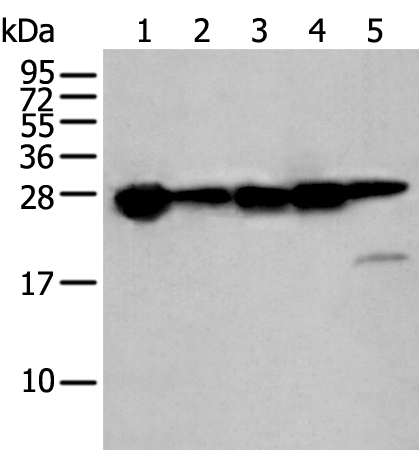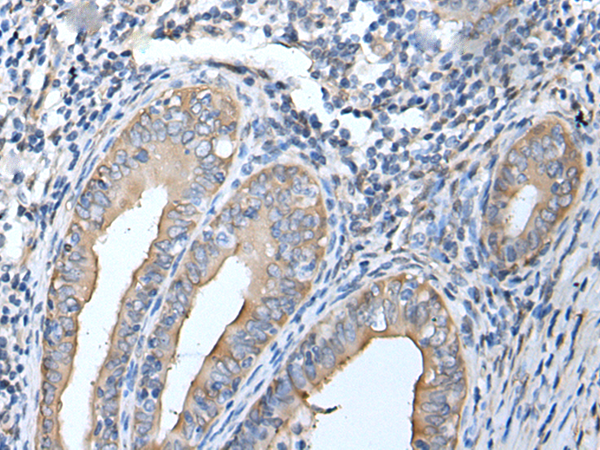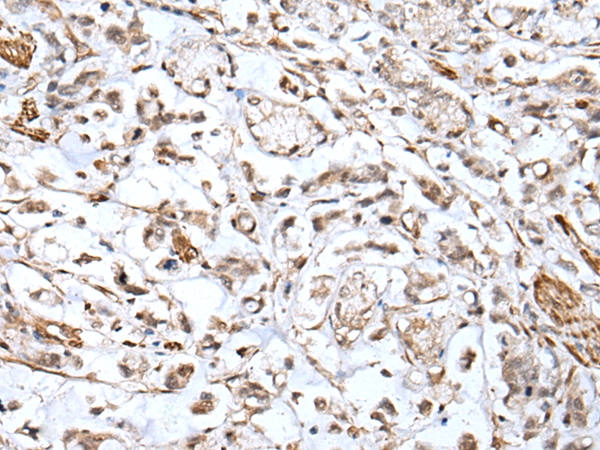


| WB | 咨询技术 | Human,Mouse,Rat |
| IF | 咨询技术 | Human,Mouse,Rat |
| IHC | 1/25-1/100 | Human,Mouse,Rat |
| ICC | 技术咨询 | Human,Mouse,Rat |
| FCM | 咨询技术 | Human,Mouse,Rat |
| Elisa | 1/5000-1/10000 | Human,Mouse,Rat |
| Aliases | CMT2F; HMN2B; HSP27; HSP28; Hsp25; SRP27; HS.76067; HEL-S-102 |
| WB Predicted band size | 23 kDa |
| Host/Isotype | Rabbit IgG |
| Antibody Type | Primary antibody |
| Storage | Store at 4°C short term. Aliquot and store at -20°C long term. Avoid freeze/thaw cycles. |
| Species Reactivity | Human |
| Immunogen | Synthetic peptide of human HSPB1 |
| Formulation | Purified antibody in PBS with 0.05% sodium azide and 50% glycerol. |
+ +
以下是关于HSPB1抗体的3篇参考文献,按文献名称、作者及摘要概括整理:
1. **"Heat shock protein 27 (HSPB1) is a prognostic biomarker in breast cancer"**
- **作者**: Ciocca, D.R. et al.
- **摘要**: 研究通过免疫组化检测乳腺癌组织中HSPB1表达,发现其高表达与患者预后不良相关,提示其可作为肿瘤侵袭性和治疗抵抗的潜在标志物。
2. **"HSPB1 phosphorylation regulates stress-induced subcellular localization and chaperone activity"**
- **作者**: Rogalla, T. et al.
- **摘要**: 利用特异性抗体分析HSPB1在氧化应激下的磷酸化状态,揭示其胞内定位变化对细胞保护功能的影响,强调抗体在追踪翻译后修饰中的关键作用。
3. **"HSPB1 mutations in Charcot-Marie-Tooth disease: mechanisms and antibody-based detection"**
- **作者**: Evgrafov, O.V. et al.
- **摘要**: 研究通过Western blot和免疫荧光抗体技术,发现HSPB1基因突变导致蛋白聚集异常,为遗传性神经病变的分子诊断提供了实验依据。
以上文献均涉及HSPB1抗体的应用,涵盖肿瘤、神经疾病及分子机制研究领域。
HSPB1 antibody targets the heat shock protein beta-1 (HSPB1), also known as HSP27. a member of the small heat shock protein (sHSP) family. This protein is ubiquitously expressed in human tissues and plays critical roles in cellular stress responses, acting as a molecular chaperone to facilitate proper folding of client proteins, prevent aggregation of denatured proteins, and promote cell survival under stress conditions. HSPB1 is regulated by phosphorylation, which modulates its oligomerization and chaperone activity. It is implicated in diverse cellular processes, including cytoskeletal stabilization, apoptosis inhibition, and oxidative stress defense.
Antibodies against HSPB1 are widely used in research to study its expression, localization, and function in both physiological and pathological contexts. In disease research, HSPB1 is associated with cancer progression (e.g., metastasis, chemoresistance), neurodegenerative disorders (e.g., Alzheimer’s, Charcot-Marie-Tooth disease), and inflammatory conditions. Its overexpression in certain cancers has prompted investigations into its potential as a diagnostic biomarker or therapeutic target.
Commercially available HSPB1 antibodies are validated for techniques like Western blotting, immunohistochemistry, and immunofluorescence. Researchers must consider post-translational modifications and tissue-specific isoforms when interpreting results. Proper controls, including knockout cell lines or siRNA knockdown, are recommended to confirm antibody specificity due to homology among sHSP family members.
×